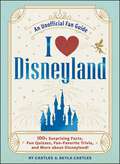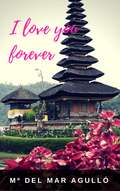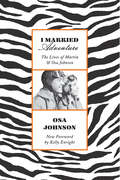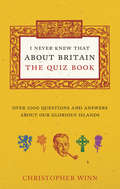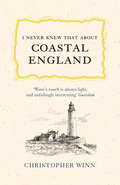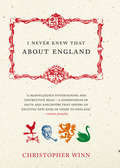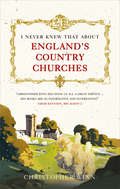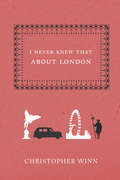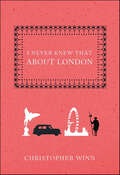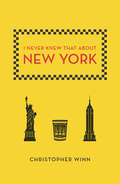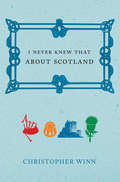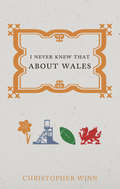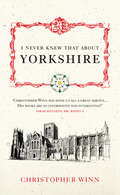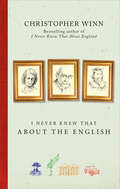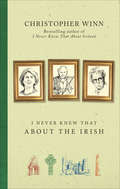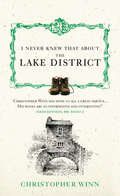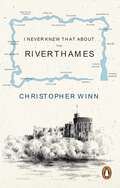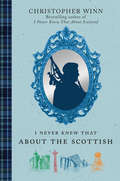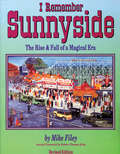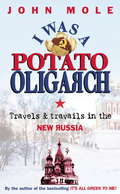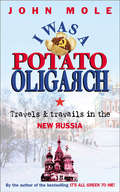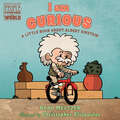- Table View
- List View
I Love Disneyland: 100+ Surprising Facts, Fun Quizzes, Fan-Favorite Trivia, and More about Disneyland! (I Love Disney Gift Book Series)
by Ry Castles Skyla CastlesGet to know Disneyland like never before with this ultimate fan guide to Disney magic, packed with insider secrets, fascinating trivia, and a comprehensive look at the Park&’s most iconic rides, attractions, and foods.Whether you&’re a seasoned Disney Parks adventurer who visits Disneyland many times a year or a lifelong Disney fan dreaming of your next trip, this book is your ticket to uncovering everything you&’ve ever wanted to know about Disneyland Resort in Anaheim, California. With I Love Disneyland, uncover Disneyland&’s amazing history since its grand opening in 1955, explore behind-the-scenes details of beloved rides like Pirates of the Caribbean and The Haunted Mansion, and test your Disney knowledge with fun and challenging trivia! You&’ll learn the answers to surprising questions like: -How did the Dole Whip come to be? -Where can you find the most exclusive, members-only bar and restaurant at Disneyland? -Which restaurant serves one of Walt&’s favorite dishes (made from a recipe provided by his daughter)? -And much more! Whether you&’re a longtime Disney fan or planning your first trip, there&’s something for everyone! It&’s the ultimate Disneyland experience that would surprise even Walt himself!
I Love You, Forever
by Annette Mª del Mar AgullóDo you believe in love at first sight? Adela is a young woman with a monotonous life that will be altered when she meets a passionate, attractive and interesting man, with whom she will learn to say I love you. Adela will realize life always brings you surprises and sometimes not always pleasant. When the concept "forever" and the word time take on a different meaning. Adela will live an atypical love story. After a disastrous first encounter and a series of impediments, she will initiate a relationship with the man she has fallen in love with. After a few months of the relationship, a new stage will come when she will have to face a new unexpected situation, which will lead her to make decisions thus changing her life. Adela will understand that in love, limits don’t exist, and there are many obstacles before you can find a solution, even if it is not the desired one. She will try to preserve a love that will escape her little by little until she reaches a point where she has to decide whether to say goodbye or cling to the past in order to move forward. Accompany Adela through her personal journey, while her fears, desires, and priorities change course, to establish new ones leading her to a new life.
I Married Adventure: The Lives of Martin and Osa Johnson (Kodansha Globe Ser.)
by Osa JohnsonA CLASSIC MEMOIR OF TWO PIONEERING ADVENTURERSBefore Joy Adamson went to Africa, before Margaret Mead sailed to Samoa, before Dian Fossey was even born, a Kansas teenager named Osa Leighty married Martin Johnson, a pioneering photographer just back from a ‘round-the-world cruise with Jack London. Together the Johnsons flew and sailed to Borneo, to Kenya, and to the Congo, filming Simba and other popular nature movies with Martin behind the camera and Osa holding her rifle at the ready in case the scene’s big game star should turn hostile. This bestselling memoir retraces their careers in rich detail, with precisely observed descriptions and often heart-stopping anecdotes. Illustrated with scores of the dramatic photos that made the Johnsons famous, it’s a book sure to delight every lover of true adventure.
I Never Knew That About Britain: Over 1000 questions and answers about our glorious isles
by Christopher WinnBestselling author and quiz master Christopher Winn is here to test your general knowledge of Britain with over 1000 quiz questions to perplex and puzzle about our glorious islands. Covering a myriad of subjects including history, cathedrals, sports, records, modern Britain, royalty, people, places, deeds, discoveries and disasters, there is something to test everyone from Britain's brainiest boffins to the quiz beginner.Featuring a range of questions from multiple choice teasers and odd ones out to picture quizzes illustrated with charming line drawings to test your knowledge of the famous faces and facades of Britain. Alongside these sit cryptic and puzzle quizzes plus special features spotlighting different regions so you can see just how well you know your local area.Perfect for all ages, this quiz book will provide hours of entertainment and education for the whole family and have you proclaiming: 'I bet you never knew that!'
I Never Knew That About Coastal England
by Christopher WinnWe all love to be beside the seaside! Be it the crunch of the sand beneath your feet, or the promise of an unexplored rock pool that draws you to the sea, prepare to be whisked away by bestselling author Christopher Winn as you delve into the charming tales of England's coastline. Divided into eighteen chapters – one for each of the coastal counties in the UK – this book will entertain and illuminate, by casting new light on the many points of intrigue to be explored along 3000 miles of spectacularly diverse and historically rich English coast. Illustrated with beautiful black-and-white line drawings, by Mai Osawa, this book makes the perfect companion for any seaside outing. You’ll find yourself exclaiming again and again – I never knew that!
I Never Knew That About England
by Christopher WinnThe inspiration for the primetime ITV series on Great Britain, this is the ultimate journey around England. Christopher Winn takes us to each county, to see where history happened, where people and ideas were born, where dreams took flight and where men and women now rest from their labours. To tread in their footsteps, to touch and experience some of what inspired and moved them is to capture some of the flavour of their lives and make their stories alive and real. Crammed with facts and information, I Never Knew That About England celebrates the places and people that make the country unique and includes history, legends, firsts, supremes, unusuals, inventions, birthplaces and gossip. You'll be able to visit the bridge where Pooh and Piglet played Poohsticks and see where Alfred burnt the cakes. In a small village in Bedfordshire you can visit the graveyard where Long John Silver and Wendy rest. These stories will bring any place that you visit to life (keep one copy in the car and one in the house!) and enable you to discover the rich and surprising history of England.
I Never Knew That About England's Country Churches
by Christopher WinnThis charming book takes you through the counties of England, exploring Saxon churches, reflective of simple faith; Norman churches with rugged arches and powerful pillars, stamping their authority, gothic churches with their soaring arches; Decorated and Perpendicular churches made glorious with Early English style and craftsmanship; Victorian churches, resplendent with imperial pomp; eccentric Arts and Crafts churches. Every one of them has a remarkable tale to tell, that will move you to exclaim, again and again: ‘I never knew that!’.
I Never Knew That About London
by Christopher WinnBestselling author Christopher Winn takes us on a captivating journey around London to discover the unknown tales of our capital's history. Travelling through the villages and districts that make up the world's most dynamic metropolis I Never Knew That About London unearths the hidden gems of legends, firsts, inventions, adventures and birthplaces that shape the city's compelling, and at times, turbulent past. See the Chelsea river views that inspired Turner in his final years and find out where London's first nude statue is. Explore London's finest country house in Charlton and unearth the secrets of the Mother of Parliaments . Spy out the village that gave its name to a car and the Russian word for railway station. Discover which church steeple gave us the design of the traditional wedding cake, where the sandwich was invented and where in Bond Street you can see London's oldest artefact. Visit the house where Handel and Jimi Hendrix both lived. Climb the famous 311 steps of the Monument, go from East to West and back again at Greenwich and fly the world's biggest big wheel. Brimming with facts, stories and snippets providing a spellbinding insight into the history of London, this beautifully illustrated gem of a book is guaranteed to inform and amuse in equal measure.
I Never Knew That About London
by Christopher WinnDiscover hundreds of fascinating facts about London in this enthralling miscellanyTravelling through the villages and districts that make up the world's most dynamic metropolis, Christopher Winn takes us on a captivating journey around London to unearth the hidden gems of legends, firsts, inventions, adventures and birthplaces that shape the city's compelling and at times turbulent past. See the Chelsea river views that inspired Turner and find out where London's first nude statue is. Explore London's finest country house in Charlton and unearth the secrets of the Mother of Parliaments. Discover which church steeple gave us the design of the traditional wedding cake, where the sandwich was invented and where in Bond Street you can see London's oldest artifact. Visit the house where Handel and Jimi Hendrix both lived. Climb the famous 311 steps of the Monument and fly the world's biggest Ferris wheel. Brimming with stories and snippets providing spellbinding insight into what has shaped the city, I Never Knew That About London is a beautifully illustrated gem of a book that informs and amuses in equal measure."Will not fail to enhance months, even years, of gentle urban exploration...Any number of morning or weekend outings can be constructed from these rich pages... the selections and observations remain unfailingly interesting." --The Guardian (UK)I Never Knew That:Tucked away below Clive Steps at the end of King Charles Street can be found the small underground rooms where Winston Churchill and the War Cabinet met during the air raids of the Second World War. The first-ever Valentine Card was written from the Tower, where in 1415 the recently imprisoned Duke of Orleans composed a love poem to his wife. The measurement of one foot comes from the length of the foot of St. Algar's statue, carved on the base of one of the columns near the entrance of St. Paul's Cathedral. The design for the traditional wedding cake is drawn from the steeple of St. Bride's church in Fleet Street.
I Never Knew That About New York
by Christopher WinnA treasure trove of fascinating trivia about the city that never sleeps Did you know: Grand Central Terminal is the largest railway station in the world. Columbus Circle is the point from which all official distances to and from New York are measured When Queen Elizabeth II visited Trinity Church in 1976, she was presented with 279 peppercorns in back rent Macy’s owns almost a full city block...but not the real estate its famous sign featuring its signature red bag is on. Take a delightful journey from the bottom of the island of Manhattan to the top and discover extraordinary facts about New York along the way. You’ll find yourself saying, "I never knew that about New York!” .
I Never Knew That About Royal Britain
by Christopher WinnWith the royal wedding around the corner, there no better time than the present to get acquainted with Royal BritainBestselling author Christopher Winn explores Britain's royal past, unearthing a rich legacy of castles and palaces, cathedrals and country retreats, battlefields and monuments where kings and queens lived and died. In this exploration of royal British history, discover whose heart is buried near the Tower of London; which palace was built on top of a mulberry garden; the world's oldest and largest occupied castle and the first building in Britain to have latrines.From the Palace of Scone to the Palace of Westminster, from Pembroke Castle, the birthplace of Henry VII, to Pontefract Castle, where Richard II starved to death, and from banqueting halls to beheading sites, this gem of a book is guaranteed to inform and amuse in equal measure.
I Never Knew That About Scotland
by Christopher WinnThe inspiration for the primetime ITV series on Great Britain, this is the ultimate journey around Scotland from bestselling author Christopher Winn. Travelling county by county, this irresistible miscellany unearths the enthralling stories, firsts, birthplaces, legends and inventions that shape the country's rich and majestic history. To uncover the spellbinding tales that lie hidden within Scotland's wild and romantic shores, to experience what inspired the country's powerful literature and towering castles, and to tread in the footsteps of her villains and victors, is to capture the spirit of this fascinating country and bring every place you visit to life. You will discover the story of the original 'sweetheart', John Balliol, whose embalmed heart is buried beside his devoted wife Devorgilla at Sweetheart Abbey in Kirkcudbrightshire. In Aberdeen you will find the only granite cathedral in the world. And you will hear the haunting echo of the Bear Gates of Traquair House in Peeblesshire were slammed shut when Bonnie Prince Charlie left Scotland in 1746 - legend has it that they will never be re-opened until a Stuart King once more sits on the throne. This beautifully illustrated treasure trove of interesting facts about the history of Scotland is the perfect gift, and will act as an eye-opening guide to this thrilling, alluring and ever-bewitching country.
I Never Knew That About Wales
by Christopher WinnThe inspiration for the primetime ITV series on Great Britain, this is a spellbinding journey around Wales by bestselling author Christopher Winn. Packed full of legends, firsts, birthplaces, inventions and adventures, I Never Knew That About Wales visits the thirteen traditional Welsh counties and unearths the hidden gems that they each hold. Discover where history and legends happened; where people, ideas and inventions began; where dreams took flight; where famous figures were born and now rest. A glittering pantheon of writers and artists, thinkers and inventors, heroes and villains have lived and toiled in this small country. Remarkable events, noble (and dastardly) deeds and exciting adventures have all taken place with Wales as their backdrop. This book seeks out their heritage, their monuments, their memories and their secrets. You'll be able to visit Britain's smallest city, St David's with its glorious 12th-century cathedral slumbering in a sleepy hollow near the sea. Explore Britain's greatest collection of castles from the first stone fortress at Chepstow to Britain's finest concentric castle at Beaumaris and the magnificent Caernarvon, birthplace of the first Prince of Wales. Browse through the second hand book capital of the world, Hay-on-Wye, wander the glorious Gower peninsula, Britain's first Area of Outstanding Natural Beauty. Take a trip to Fishguard, where the last invasion of Britain took place in 1797. Marvel at Thomas Telford's Menai Bridge, the world's first iron suspension bridge or Pontcysyllte, the longest bridged aqueduct in Britain. This irresistible compendium of interesting facts and good stories will give you a captivating insight into the people, ideas and events that have shaped the individual identity of every place you visit, and will have you exclaiming again and again: 'Well, I never knew that!'
I Never Knew That About Yorkshire
by Christopher WinnBestselling author Christopher Winn takes us on an intriguing journey through Britain's largest county, uncovering the hidden places, legends, secrets and fascinating characters of this unique and compelling piece of England. From England's largest vale and northern Europe's largest gothic cathedral to Britain's oldest city, Yorkshire is home to some of Britain's best architecture, most ravishing scenery and is the cradle of some of our country's most influential and individual characters. You will discover the only clog factory in the world, the first English actor to win an Oscar, the world's oldest association football club and largest expanse of medievel stained glass. This gem of a book will act as a wonderfully surprising and highly entertaining guide to one of England's best loved counties.
I Never Knew That About the English
by Christopher WinnThis wonderful book takes an affectionate, entertaining and perceptive look at the English people. Here are their traditions, foibles, quirks, customs, humour and achievements, triumphs and failures, peccadilloes and passions. Travel through England from coast to coast and learn how every county contributes in unique and different ways to the distinct English personality. Marvel at crooked black and white halls in Cheshire and soft golden stone cottages in Midland villages. Go cheese rolling in Gloucestershire, discover the origins of cricket in Hampshire, savour a hot pot in Lancashire and a pudding in Yorkshire. Gasp at the glories of stately homes and the families that create them, upstairs and down, enjoy a pint. Listen to the memories and tales of ordinary folk from every walk of life and find out from them what it means to be English. This irresistible book is packed with fascinating trivia and amusing stories that will entertain and inform for hours on end.
I Never Knew That About the Irish
by Christopher WinnIn this charming book bestselling author Christopher Winn turns his attention to the Irish people, taking us on a enthralling journey around their homeland, discovering en route the intriguing and surprising ways the places and their history contribute to the Irish character. As he travels across the Emerald Isle, he unearths the traditions, triumphs and disasters, foibles, quirks and customs that come together to make up the Irish people. From County Leitrim, the most sparsely populated county in the Republic of Ireland to County Louth, Ireland's smallest county, discover the site of the first play performed in the Irish language, sail the longest navigable inland waterway in Europe and watch the horse racing at Ireland's first all-weather racecourse. Illustrated throughout with enchanting pen and ink drawings and packed with interesting facts and entertaining stories, myths and legends, I Never Knew That About the Irish will entertain the whole family for hours on end.
I Never Knew That About the Lake District
by Christopher WinnBestselling author Christopher Winn takes us on a fascinating journey through the Lake District, that majestic landscape in Cumbria beloved of poets and tourists, hill walkers, seekers of scenic beauty and those who mess about in boats. Learn about the hidden places, the secrets and legends, wild characters and human stories that haunt England's most mountainous region - from England's wettest place to the country's highest point, from the birthplace of Postman Pat to the resting place of Poet Laureates.
I Never Knew That About the River Thames
by Christopher WinnBestselling author Christopher Winn takes us on a captivating journey out of London along the banks of the River Thames to discover the secrets and stories of England's most famous waterway. Discover the Thames's literary heritage at Pangbourne, near Reading, famous as the home of The Wind in the Willows's Kenneth Grahame, then explore Mapledurham House, the inspiration for its famous Toad Hall. Explore Henley-on-Thames, where the first Oxford and Cambridge boat races were held, then marvel at Southend Pier, the longest pleasure pier in the world.As he follows the river from source to sea, visiting its towns, villages and places of interest, Winn unearths a fascinating array of facts, folklore, landmarks and legends that are guaranteed to have you exclaiming 'I Never Knew That!'. Illustrated with line drawings this charming gem of a book is guaranteed to inform and delight in equal measure.
I Never Knew That About the Scottish
by Christopher WinnIn this captivating book bestselling author Christopher Winn turns his attention to the Scottish people, taking us on an eye-opening journey around their homeland, discovering en route the intriguing and surprising ways the places and their history contribute to the Scottish character. As he travels through Scotland's Highlands and cities he unearths the traditions, triumphs and disasters, foibles, quirks and customs that come together to make up the Scottish people. From the Scottish capital Edinburgh, birthplace of Henry Brougham who made the longest ever speech in the House of Commons, lasting over six hours, to Callander, birthplace of Helen Duncan, the last person in Britain to be imprisoned for witchcraft after correctly diving the sinking of HMS Hood, he accompanies us on a journey uncovering little-known facts, trivia and amusing anecdotes. Illustrated throughout with beguiling pen and ink drawings I Never Knew That About the Scottish is guaranteed to have you exclaiming: 'I never knew that!'
I Regret Almost Everything: A Memoir
by Keith McNallyThe entertaining, irreverent, and surprisingly moving memoir by the visionary restaurateur behind such iconic New York institutions as Balthazar and Pastis. A memoir by the legendary proprietor of Balthazar, Pastis, Minetta Tavern, and Morandi, taking us from his gritty London childhood in the fifties to his serendipitous arrival in New York, where he founded the era-defining establishments the Odeon, Cafe Luxembourg, and Nell&’s. Eloquent and opinionated, Keith McNally writes about the angst of being a child actor, his lack of insights from traveling overland to Kathmandu at nineteen, the instability of his two marriages and family relationships, his devastating stroke, and his Instagram notoriety.
I Remember Sunnyside
by Mike FileyFirst published in 1982, I Remember Sunnyside is a mine of golden memories, bringing back to life an earlier Toronto, only hints of which remain today.Like the city itself, Sunnyside was an everchanging landscape from its heady opening days in the early 1920s to its final sad demolition in the 1950s. The book captures the spirit of the best of times a magical era which can only be recaptured in memory and photographs. It also presents the reality of a newer Toronto where change, although necessary, is sometimes regrettable.
I Sailed With Columbus
by Miriam SchleinDescribes Columbus' first voyage of discovery as seen through the eyes of a twelve-year-old ship's boy.
I Was a Potato Oligarch
by John MoleIn this eye-wateringly funny account from John Mole, readers will experience "the real Russia" firsthand. Beginning with a risky business venture inspired by British fast food, Mole attempts to submerge himself in Russian culture-but often finds himself in the middle of a fiasco instead.
I Was a Potato Oligarch: Travels and Travails in the New Russia
by John MoleIn a charming saga of sun, sea, sand - and cement - John Mole tells of the back-breaking but joyous labours of fixing up his own Arcadia and introduces a warm, generous and garrulous cast of characters who helped (and occasionally hindered) his progress.
I am Curious: A Little Book About Albert Einstein (Ordinary People Change the World)
by Brad MeltzerThe littlest readers can learn about Albert Einstein in this board book version of the New York Times bestselling Ordinary People Change the World biography.This friendly, fun biography series focuses on the traits that made our heroes great--the traits that kids can aspire to in order to live heroically themselves. In this new board book format, the very youngest readers can learn about an icon in the series's signature lively, conversational way. The short text focuses on drawing inspiration from these iconic heroes, and includes an interactive element and factual tidbits that young kids will be able to connect with. This volume tells the story of Albert Einstein, one of the world's greatest scientists.
